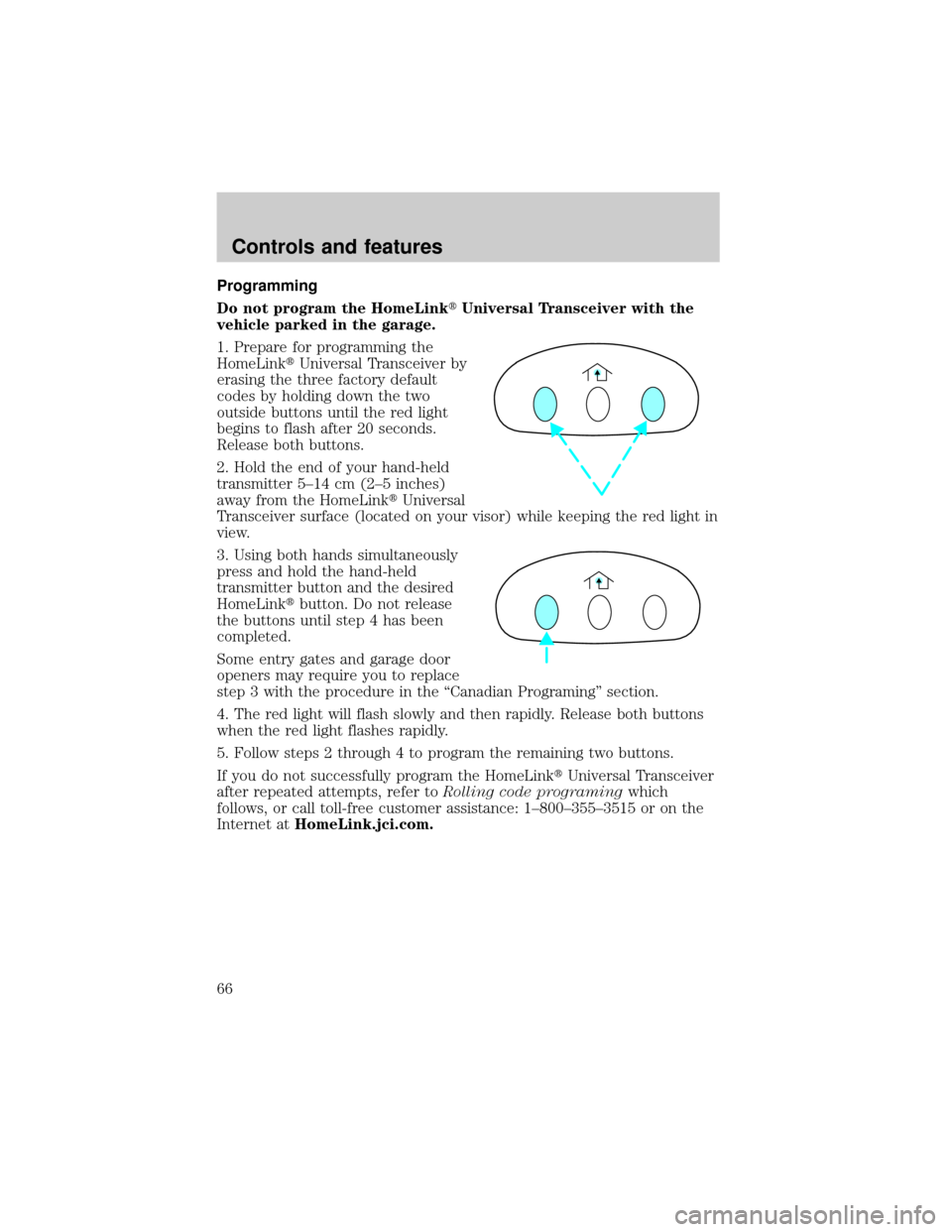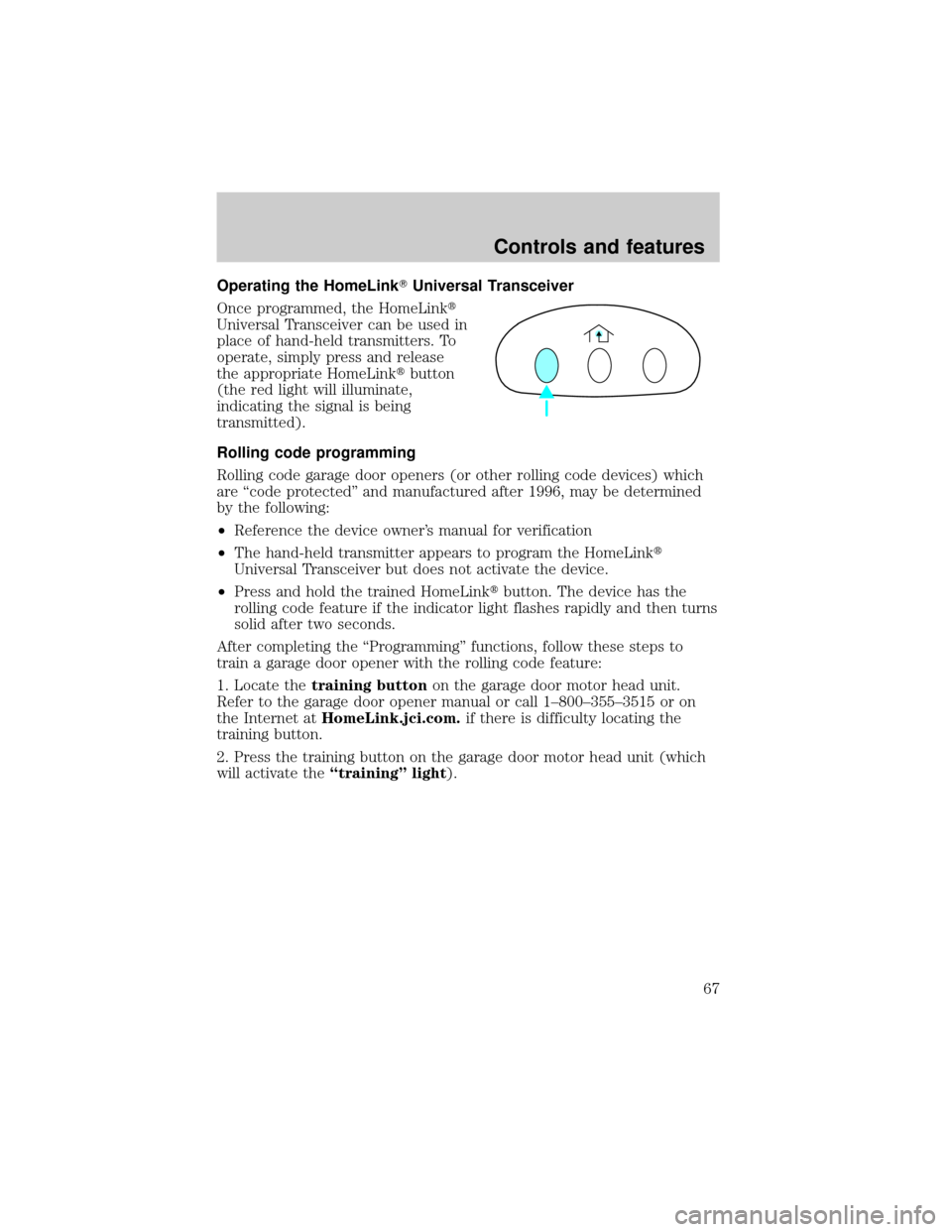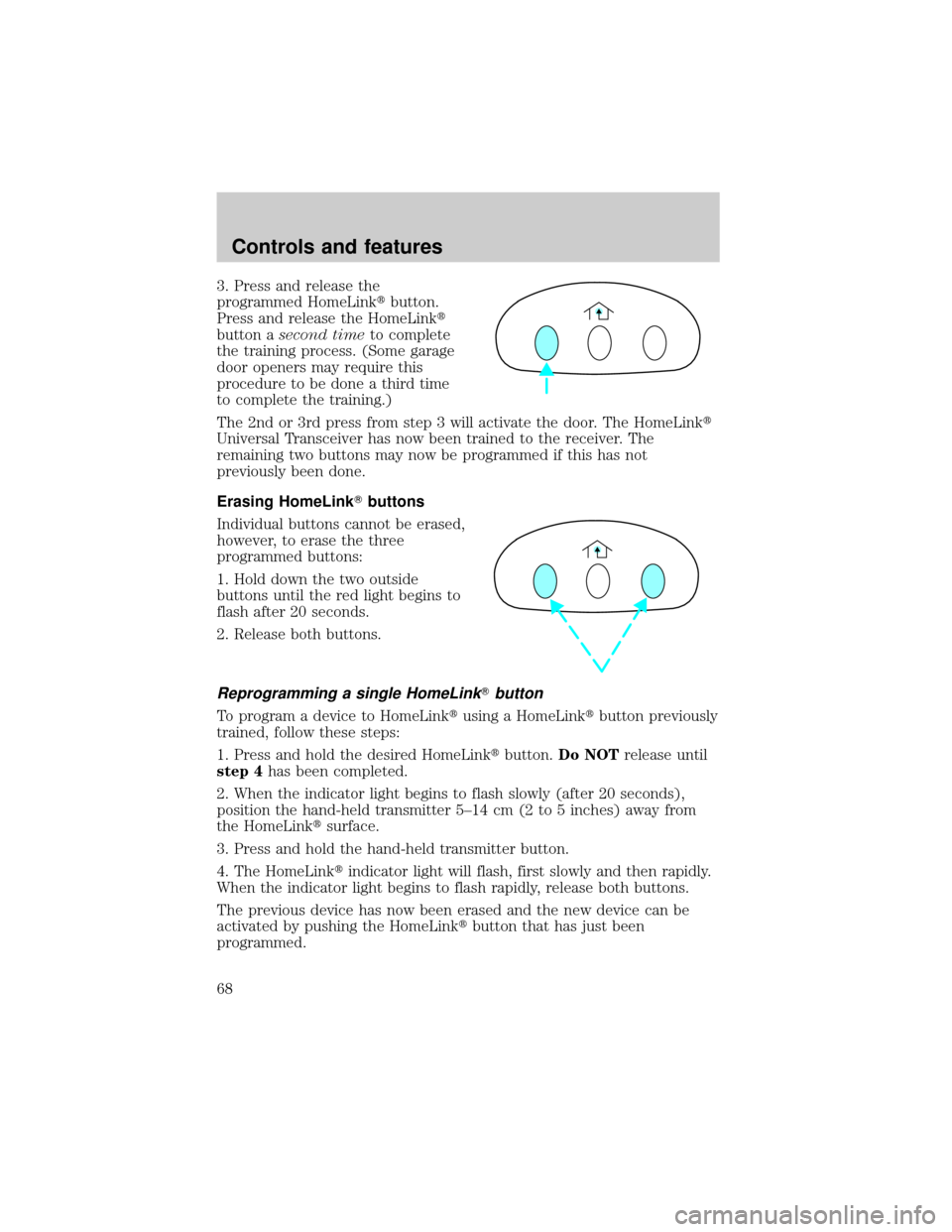2002 LINCOLN BLACKWOOD garage door opener
[x] Cancel search: garage door openerPage 65 of 248

ILLUMINATED VISOR MIRROR
Lift the mirror cover to turn on the
visor mirror lamps.
HOMELINKTUNIVERSAL TRANSCEIVER
The HomeLinktUniversal Transceiver, located on the driver's visor,
provides a convenient way to replace up to three hand-held transmitters
with a single built-in device. This feature will learn the radio frequency
codes of most current transmitters to operate garage doors, entry gates,
security systems, entry door locks, and home or office lighting.
When programming your HomeLinktUniversal Transceiver, to a
garage door or gate be sure that people and objects are out of
the way to prevent potential harm or damage.
Do not use the HomeLinktUniversal Transceiver with any garage door
opener that lacks safety stop and reverse features as required by U.S.
federal safety standards (this includes any garage door opener model
manufactured before April 1, 1982). A garage door which cannot detect
an object, signaling the door to stop and reverse, does not meet current
U.S. federal safety standards. For more information on this matter, call
toll-free: 1±800±355±3515 or on the Internet atHomeLink.jci.com.
Controls and features
65
Page 66 of 248

Programming
Do not program the HomeLinktUniversal Transceiver with the
vehicle parked in the garage.
1. Prepare for programming the
HomeLinktUniversal Transceiver by
erasing the three factory default
codes by holding down the two
outside buttons until the red light
begins to flash after 20 seconds.
Release both buttons.
2. Hold the end of your hand-held
transmitter 5±14 cm (2±5 inches)
away from the HomeLinktUniversal
Transceiver surface (located on your visor) while keeping the red light in
view.
3. Using both hands simultaneously
press and hold the hand-held
transmitter button and the desired
HomeLinktbutton. Do not release
the buttons until step 4 has been
completed.
Some entry gates and garage door
openers may require you to replace
step 3 with the procedure in the ªCanadian Programingº section.
4. The red light will flash slowly and then rapidly. Release both buttons
when the red light flashes rapidly.
5. Follow steps 2 through 4 to program the remaining two buttons.
If you do not successfully program the HomeLinktUniversal Transceiver
after repeated attempts, refer toRolling code programingwhich
follows, or call toll-free customer assistance: 1±800±355±3515 or on the
Internet atHomeLink.jci.com.
Controls and features
66
Page 67 of 248

Operating the HomeLinkTUniversal Transceiver
Once programmed, the HomeLinkt
Universal Transceiver can be used in
place of hand-held transmitters. To
operate, simply press and release
the appropriate HomeLinktbutton
(the red light will illuminate,
indicating the signal is being
transmitted).
Rolling code programming
Rolling code garage door openers (or other rolling code devices) which
are ªcode protectedº and manufactured after 1996, may be determined
by the following:
²Reference the device owner's manual for verification
²The hand-held transmitter appears to program the HomeLinkt
Universal Transceiver but does not activate the device.
²Press and hold the trained HomeLinktbutton. The device has the
rolling code feature if the indicator light flashes rapidly and then turns
solid after two seconds.
After completing the ªProgrammingº functions, follow these steps to
train a garage door opener with the rolling code feature:
1. Locate thetraining buttonon the garage door motor head unit.
Refer to the garage door opener manual or call 1±800±355±3515 or on
the Internet atHomeLink.jci.com.if there is difficulty locating the
training button.
2. Press the training button on the garage door motor head unit (which
will activate theªtrainingº light).
Controls and features
67
Page 68 of 248

3. Press and release the
programmed HomeLinktbutton.
Press and release the HomeLinkt
button asecond timeto complete
the training process. (Some garage
door openers may require this
procedure to be done a third time
to complete the training.)
The 2nd or 3rd press from step 3 will activate the door. The HomeLinkt
Universal Transceiver has now been trained to the receiver. The
remaining two buttons may now be programmed if this has not
previously been done.
Erasing HomeLinkTbuttons
Individual buttons cannot be erased,
however, to erase the three
programmed buttons:
1. Hold down the two outside
buttons until the red light begins to
flash after 20 seconds.
2. Release both buttons.
Reprogramming a single HomeLinkTbutton
To program a device to HomeLinktusing a HomeLinktbutton previously
trained, follow these steps:
1. Press and hold the desired HomeLinktbutton.Do NOTrelease until
step 4has been completed.
2. When the indicator light begins to flash slowly (after 20 seconds),
position the hand-held transmitter 5±14 cm (2 to 5 inches) away from
the HomeLinktsurface.
3. Press and hold the hand-held transmitter button.
4. The HomeLinktindicator light will flash, first slowly and then rapidly.
When the indicator light begins to flash rapidly, release both buttons.
The previous device has now been erased and the new device can be
activated by pushing the HomeLinktbutton that has just been
programmed.
Controls and features
68
Page 235 of 248

Hood deflectors
Locking gas cap
Molded ªall weatherº vinyl floor mats
Side window air deflectors
Spare tire lock
Truck cover
Underbody vehicle lighting
Universal floor mats
Wheels
For maximum vehicle performance, keep the following information in
mind when adding accessories or equipment to your vehicle:
²When adding accessories, equipment, passengers and luggage to your
vehicle, do not exceed the total weight capacity of the vehicle or of
the front or rear axle (GVWR or GAWR as indicated on the Safety
compliance certification label). Consult your dealer for specific weight
information.
²The Federal Communications Commission (FCC) and Canadian Radio
Telecommunications Commission (CRTC) regulate the use of mobile
communications systems - such as two-way radios, telephones and
theft alarms - that are equipped with radio transmitters. Any such
equipment installed in your vehicle should comply with FCC or CRTC
regulations and should be installed only by a qualified service
technician.
²Mobile communications systems may harm the operation of your
vehicle, particularly if they are not properly designed for automotive
use or are not properly installed. When operated, such systems may
cause the engine to stumble or stall or cause the transmission to be
damaged or operate improperly. In addition, such systems may be
damaged or their performance may be affected by operating your
vehicle. (Citizens band [CB] transceivers, garage door openers and
other transmitters with outputs of five watts or less will not ordinarily
affect your vehicle's operation.)
²Ford cannot assume responsibility for any adverse effects or damage
that may result from the use of such equipment.
Customer assistance
235
Page 240 of 248

lubrication specifications ......220,
222
refill capacities ........................218
service points ..........................170
starting after a collision .........148
Engine oil ..................................171
checking and adding ..............171
dipstick ....................................171
filter, specifications ........173, 218
recommendations ...................173
refill capacities ........................218
specifications ..................220, 222
Exhaust fumes ..........................128
F
Fail safe cooling ........................180
Floor mats ...................................73
Fluid capacities .........................218
Foglamps .....................................17
Four-Wheel Drive vehicles
preparing to drive your
vehicle .....................................135
Fuel ............................................194
calculating fuel economy .......199
cap ...........................................198
capacity ...................................218
choosing the right fuel ...........196
comparisons with EPA fuel
economy estimates .................202
detergent in fuel .....................197
filling your vehicle with
fuel ...........................194, 198±199
filter, specifications ........198, 218
fuel pump shut-off switch .....148
gauge .........................................13
improving fuel economy ........199
low fuel warning light ................8
octane rating ...................196, 222quality ......................................197
running out of fuel .................197
safety information relating to
automotive fuels .....................194
Fuses ..................................150±151
G
Garage door opener ....................65
Gas cap (see Fuel cap) ............198
Gas mileage
(see Fuel economy) .................199
Gauges .........................................13
battery voltage gauge ...............15
engine coolant temperature
gauge .........................................14
engine oil pressure gauge ........16
fuel gauge ..................................13
odometer ...................................15
speedometer .............................14
tachometer ................................15
trip odometer ............................15
GAWR (Gross Axle
Weight Rating) ..........................139
calculating ...............................141
definition .................................139
driving with a heavy load ......139
location ....................................139
GVWR (Gross Vehicle
Weight Rating) ..........................139
calculating .......................139, 141
definition .................................139
driving with a heavy load ......139
location ....................................139
H
Hazard flashers .........................148
Head restraints .....................90, 95
Index
240
Page 241 of 248

Headlamps ...................................17
aiming ..............................210±211
autolamp system .......................18
bulb specifications ..................209
flash to pass ..............................17
high beam ...........................10, 17
replacing bulbs .......................204
turning on and off ....................17
warning chime ..........................13
Heating ........................................41
HomeLink universal
transceiver (see Garage
door opener) .........................65±68
Hood ..........................................169
I
Ignition .................................49, 222
Infant seats
(see Safety seats) .....................118
Inspection/maintenance (I/M)
testing ........................................203
Instrument panel
cleaning ...................................216
cluster ..................................8, 216
lighting up panel
and interior ...............................18
location of components ..............8
J
Jack ............................................157
positioning ...............................157
storage .....................................157
Jump-starting your vehicle ......162K
Keyless entry system
autolock .....................................85
locking and
unlocking doors ..................88±89
programming entry code .........88
Keys .................................49, 77±79
key in ignition chime ...............12
positions of the ignition ...........49
valet key ....................................49
L
Lamps
autolamp system .......................18
bulb replacement
specifications chart ................209
cargo lamps ...............................18
fog lamps ...................................17
headlamps .................................17
headlamps, flash to pass ..........17
instrument panel, dimming .....18
interior lamps .............63±64, 208
replacing bulbs .......204, 206±208
Lane change indicator
(see Turn signal) ........................49
Liftgate ........................................73
Lights, warning and indicator ......8
air bag ..........................................9
air suspension .........................133
anti-lock brakes (ABS) ....10, 129
anti-theft ...................................10
brake ..........................................10
charging system ........................11
check coolant ............................11
door ajar ....................................11
engine oil pressure ...................11
high beam .................................10
low fuel ........................................8
Index
241